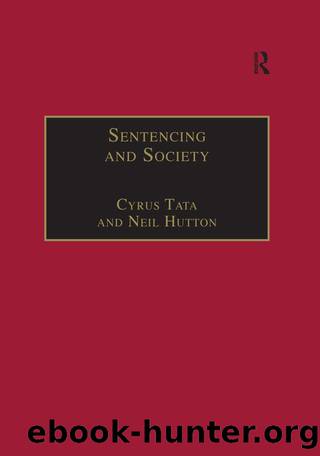Sentencing and Society by Tata Cyrus;Hutton Neil; & Neil Hutton

Author:Tata, Cyrus;Hutton, Neil; & Neil Hutton
Language: eng
Format: epub
Publisher: Taylor & Francis Group
In the regression using senunit as the dependent variable, using a firearm is very significant - adding an estimated 1.2 senunits. It is difficult to believe that using a firearm in an armed robbery would not have a significant impact on judges' sentencing decisions. This finding provides additional plausibility to the results of senunit.
There are major differences regarding the substantive inferences one can draw from interpreting the coefficients in the two equations. For example, we begin by comparing the coefficients for 'high severity felony convictions'. In the senunit regression, the coefficient is 2.415, whereas in the actual months regression the coefficient is 24.130. The presence of prior high severity convictions leads judges to increase sentences by 2.5 sentencing units (i.e. 2.415) over and above the 'base sentence' implied by the values of the other variables in the model. Figure 13.2(a) is a visual representation of the impact of this variable for different base sentences. At the low end of the scale, where one senunit corresponds to 6 months, the impact is about 15 months (2.415 x 6). At the high end, when one senunit equals 10 years, the effect of high severity convictions is about 25 years (2.415 x 10).
* * *
The offender having a substantial number of other aggravating factors has his sentence enhanced substantially in actual months; it increases two and one half sentencing units. The ultimate marginal impact depends on the values of the other variables in the model.
In the actual months regression, the coefficient indicates a high severity conviction leads to a sentence increase of two years, no matter what values the other variables take on. Figure 2(b) is a visual representation of the impact in the actual months regression.
The ratios between 120 and 60 months, and 120 and 12 months, are 1.63 and 6.5 respectively. These ratios are almost identical to the ratios presented in Table 3 using the present value of the sentences (based upon a 10 per cent discount rate).
The sentencing unit differs from other measures of seventy for four, theoretically based reasons. It makes decision-making feasible. It focuses attention on a reduced number of prominent options. It hypothesises that judges engage in a form of psychological discounting so that the just noticeable difference between successive sentences requires increasing the intervals between elements of the sentencing unit. Two questions remain. Is the sentencing unit an interval/ratio scale? Does senunit make a substantive difference to our inferences?
Figure 13.2(a) Marginal impact of high severity felony on senunit
Download
This site does not store any files on its server. We only index and link to content provided by other sites. Please contact the content providers to delete copyright contents if any and email us, we'll remove relevant links or contents immediately.
The 1921 Tulsa Race Massacre by Chris M. Messer(239)
Introduction to Criminal Justice - A Balanced Approach by Brian K. Payne Willard M. Oliver Nancy E. Marion(226)
Russia's Sakhalin Penal Colony, 1849â1917 by Andrew A. Gentes(219)
The History of Newgate Prison by Jowett Caroline;(212)
Punishing the Poor The Neoliberal Government of Social Insecurity by Unknown(200)
A History of Police and Masculinities, 1700-2010 by David G. Barrie Susan Broomhall(173)
Serial Killers America and UK - 2 BOOKS IN 1 by Clark Matthew(166)
Restorative Justice in Transitional Settings by Kerry Clamp(137)
Culture, Crime and Punishment by Ronald Kramer(132)
Policing Gender, Class And Family In Britain, 1800-1945 by Linda Mahood(130)
Routledge Handbook on Immigration and Crime by Holly Ventura Miller Anthony Peguero(130)
Organized Crime and Corruption Across Borders by T. Wing Lo Dina Siegel Sharon I Kwok(129)
Cops, Cameras, and Crisis by Michael D. White Aili Malm(129)
Dangerousness, Risk and the Governance of Serious Sexual and Violent Offenders by Karen Harrison(126)
The Real CSI by Kate Bendelow(125)
Women Exiting Prison by Bree Carlton Marie Segrave(118)
A Theory of African American Offending by James D. Unnever Shaun L. Gabbidon(113)
Losing Legitimacy by Gary Lafree(112)
Using Murder by Philip Jenkins(110)
